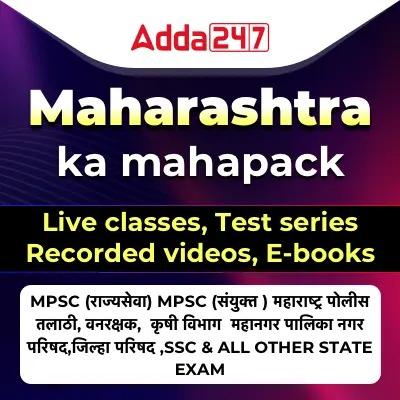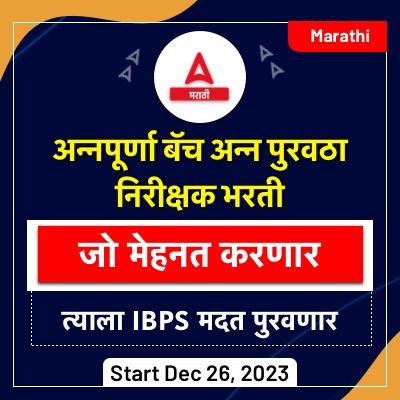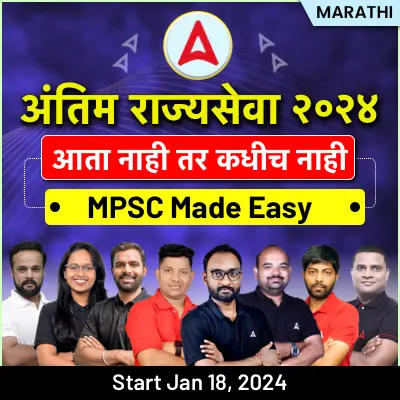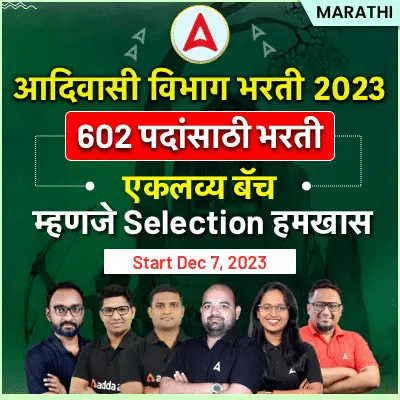Table of Contents
Paragraph Completion
Paragraph Completion: महाराष्ट्रातील तसेच राज्यातील बहुतेक स्पर्धा परीक्षेचा महत्वाचा विषय म्हणजे इंग्लिश. इंग्लिश विषयात जास्तकरून इंग्लिश ग्रामर वर प्रश्न विचारले जातात. नेहमीच्या सरावाने इंग्लिश विषयात चांगले गुण मिळू शकतात. आगामी काळातील सरळसेवा भरती जसे की, अन्न व नागरी पुरवठा भरती आणि इतर स्पर्धा परीक्षांमध्ये इंग्लिश ग्रामरला विशेष महत्त्व आहे. इंग्लिश ग्रामर चे रोज वाचन फायदेशीर ठरते. इंग्लिश ग्रामर मधील एक महत्वपूर्ण घटक म्हणजे Paragraph Completion. यावर परीक्षेत हमखास 1 ते 2 प्रश्न विचारले जाऊ शकतात. या लेखात आपण Paragraph Completion व त्यातील महत्वाचे नियम यावर माहिती पाहणार आहोत.
Paragraph Completion: विहंगावलोकन
इंग्रजी व्याकरणाचा अभ्यास करतांना Paragraph Completion या घटकाचा अभ्यास करणे महत्वाचे ठरते. या लेखात Paragraph Completion बद्दल सविस्तर माहिती दिली आहे.
| Paragraph Completion: विहंगावलोकन | |
| श्रेणी | अभ्यास साहित्य |
| उपयोगिता | अन्न व नागरी पुरवठा भरती आणि इतर सर्व स्पर्धा परीक्षांसाठी उपयुक्त |
| विषय | इंग्रजी व्याकरण |
| लेखाचे नाव | Paragraph Completion |
| लेखातील प्रमुख मुद्दे |
|
How to Solve
Paragraph completion questions follow a clear line of reasoning. These questions in the exams are based on paragraphs excerpted from Newspapers, Magazines, Journals, etc. They are rarely original paragraphs written specially for the exam. Hence the methodology that good writers use to complete their paragraphs holds true for the answer choice; your duty, therefore is to understand the line of reasoning used by the writer. If followed appropriately then scoring becomes easier.
A paragraph is a short composition or note on an idea that is complete in itself. Hence the last sentence of a paragraph will have the following characteristics:
• It fulfils the purpose of the paragraph.
• It brings the paragraph to a smooth closure.
• It does not introduce (contain) any new ideas.
• It is not an inference.
You need to not only read the paragraph actively and carefully, but also identify its purpose as you read. The last sentence will merely fulfil this purpose and bring the paragraph to a smooth closure. The last sentence, hence, arises from the paragraph itself and not from outside it. If required, you must read the paragraph several times or until you have identified the purpose for which it is written. The operative idea in the directions to the questions is “… choose the one that completes the paragraph”. A sentence that completes the paragraph hence cannot logically introduce any new ideas. That is why the last sentence will contain nothing that requires further clarification. The paragraph needs to be closed with the last sentence; it should not leave loose ends to be closed or explained further.
What does a smooth conclusion mean?
When we say that “The last sentence concludes the paragraph”, the word ‘conclude’, in this context, merely means to bring to an end. It does not mean that you have to reason out on the basis of the given facts and reach a judgment or decision or an inference. You —as a test taker—have to merely notice the direction in which the paragraph is moving and choose the best sentence that brings it to an end. The reader hence is not actively involved in the paragraph, except in identifying the writer’s purpose in writing the paragraph. If you are able to unravel, by looking at the details given in the paragraph, the direction and purpose of the writer, the scoring option stands out from the other options very clearly and conspicuously.
You must spend sufficient time with the paragraph before going to the options to evaluate them for the answer. Some of these questions can be, at times, prove themselves to be extremely tricky if you haven’t understood the purpose of the paragraph. Then, all options can appear right.
Another point to bear in mind is that the task in these questions is to complete the paragraph and not merely continue it. The difference between an option that completes the paragraph and an option that continues the paragraph is that the former fulfils the purpose of the paragraph whereas the latter merely continues one or the other of the ideas mentioned in the paragraph. However, in certain questions an option that continues the paragraph may be accommodated as the last sentence (answer) if a sentence (option) that brings the paragraph to a logical closure is not available. Look at the following example. “I am sometimes attacked for imposing “rules.” Nothing could be further from the truth. I hate rules. All I do is report on how consumers react to different stimuli. I may say to a copywriter, “Research shows that commercials with celebrities are below average in persuading people to buy products. Are you sure you want to use a celebrity?” Call that a rule? Or I may say to an art director, “Research suggests that if you set the copy in black type on a white background, more people will read it than if you set it in white type on a black background……………..”
What is the purpose of the above paragraph? The writer is at pains to explain to us that he does not want to be seen as framing rules for anyone. He hates rules. He tells us the different situations which had led to this (erroneous) belief, among others, that he is laying down rules; but he was merely ‘reporting’ consumer behaviour. He tells us those examples are not rules. So, the purpose of the paragraph is to tell us that whatever he says to others are not rules. They are merely reports, in order that the other may reconsider his or her stand in relation to consumer behaviour.
Now we need to close this paragraph without leaving any loose ends.
Options:
A. Guidance based on applied research can hardly qualify as “rules.”
B. Thus, all my so called “rules” are rooted in applied research.
C. A suggestion perhaps, but scarcely a rule. Such principles are unavoidable if one wants to be systematic about consumer behaviour.
D. Fundamentally it is about consumer behaviour — not about celebrities or type settings.
E. The findings of research done by London Business School reveal an interesting fact.
Options A and B. “Guidance based on applied research can hardly qualify as ‘rules’” and, “Thus, all my so called ‘rules’ are rooted in applied research.” ring completely untrue because “guidance based on applied research” only reinforces the claim of others that those are strict and rigid principles that no one can refute—by implication stricter than rules. Option D, “Such principles are unavoidable if one wants to be systematic about consumer behaviour,” is in not related to the purpose of the paragraph which is not about how to be systematic about consumer behaviour. In the same vein option E is also far away from the purpose of the writer as it introduces a new topic (research work of London Business School). Option C. “A suggestion perhaps but scarcely a rule,” fulfils the writer’s purpose that they are not rules but merely suggestions. This sentence, read in conjunction with the following “I am sometimes attacked for imposing ‘rules’. Nothing could be further from the truth. I hate rules. …. Call that a rule? Or I may say to an art director …” makes the paragraph a logically complete unit. Hence Option C is the answer. Now try to solve the questions given in the exercise and read newspapers, magazines, journals, etc. as much as you can in order to improve your reading skills.
Paragraph Completion: नमुना प्रश्न
Directions (1-3): Each of the following questions has a paragraph from which last sentence has been deleted. From the given options, choose the one that completes the paragraph in the most appropriate way.
1. By calling for exempting unionized businesses from the minimum wage, unions are creating more incentives for employers to favor unionized workers over the non-unionized sort. Such exemptions strengthen their power. This is useful because for all the effort unions throw at raising the minimum wage laws for better pay have an awkward habit of undermining union clout ……………………
(a) High rates of unionization make minimum-wage rules unnecessary as collaborative wage setting achieves the flexibility goals of a low minimum wage and the fairness goals of a high one.
(b) Workers who have no real alternative to employment in the unregulated shadows of the labor market are even more vulnerable to exploitation and abuse than workers with the legal right to take low wages.
(c) The labor ethos of worker solidarity seems hollow if non-union workers are underpriced by union workers and left unemployed or scrambling for unauthorized work.
(d) Once employers are obliged to pay the same minimum wage to both unionized and non-unionized labor, workers often see less reason to pay the dues to join a union.
(e) However, labors do not want to join a union because the dues they pay to join the same adds to the burden on them.
2. Trade protectionism, disguised as concern for the climate, is raising its head. Citing competitiveness concerns, powerful industrialized countries are holding out threats of a levy on imports of energy intensive products from developing countries that refuse to accept their demands. The actual source of protectionist sentiment in the OECD countries is, of course, their current lackluster economic performance, combined with the challenges posed by the rapid economic rise of China and India – in that order.
(a) Climate change is evoked to bring trade protectionism through the back door.
(b) OECD countries are taking refuge in climate change issues to erect trade barriers against these two countries.
(c) Climate change concerns have come as a convenient stick to beat the rising trade power of China and India.
(d) Defenders of the global economic status quo are posing as climate change champions.
(e) Today’s climate change champions are the perpetrators of global economic inequity.
3. The 16th century in Europe was a great century of change. The humanists and artists of the Renaissance would help characterize the age as one of individualism and self-creativity. Humanists such as Petrarch helped restore the dignity of mankind while men like Machiavelli injected humanism into politics. When all is said and done, the Renaissance helped to secularize European society……………..
(a) The year 1543 can be said to have marked the origin of the Scientific Revolution, with Copernicus publishing De Revolutionibus and setting in motion a wave of scientific advance.
(b) The century witnessed the growth of royal power, the appearance of centralized monarchies and the discovery of new lands.
(c) The very powerful notion that man makes his own history and destiny took root. (d) In the meantime, urbanization continued unabated as did the growth of universities.
(e) Besides this, industrialisation also played an important role inthe development of Europe.
Solution:
1. (d)
2. (d)
3. (c)
महाराष्ट्रातील सर्व स्पर्धा परीक्षांसाठी ऑनलाईन क्लास, व्हिडिओ कोर्स, टेस्ट सिरीज, पुस्तके आणि इतर अभ्यास साहित्य खाली दिलेल्या लिंक वर क्लिक करून मिळावा.
अड्डा 247 मराठी अँप | अड्डा 247 मराठी टेलिग्राम ग्रुप
